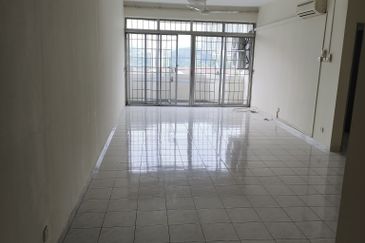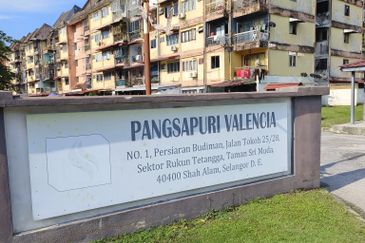
KUALA LUMPUR (Nov 22): These are rather pessimistic times and I hate to be throwing in more pessimism. However, the recent budget and the controversies it has generated is not only a symptom of Malaysia’s problems but it is also a distraction from the troubling problems that are undermining the growth prospects of the Malaysian economy.
I have become increasingly concerned by a number of negative trends that have prevailed for some time, which are not receiving the attention they should. If these trends are not reversed, they will have significant negative consequences for Malaysia’s economic growth and will erode the economic welfare of its citizens. Not addressing these adverse trends may not only jeopardise Malaysia’s opportunity to become a high-income nation, it may even lead to the nation regressing from where it is today. There are five trends that I am particularly concerned about.
Loss of economic dynamism and slower growth
As Chart 1 shows, something seems to have gone out of the Malaysian economy after the Asian Financial Crisis (AFC) and it seems to have become less dynamic and experienced weaker growth. In the decade before the AFC, cumulative annual growth was 8.39%. In the two decades since the AFC, this has fallen to 4.58%, or just over one-half of what it was during the pre-crisis period. So, what happened?
In the period of mid-1980s to mid-1990s, the liberalisation of Malaysia’s foreign investment rules coincided with the Plaza Accord that drove significant outward investment by Japanese companies. Malaysia benefited from the FDI inflows with a surge in manufacturing activity and a strong growth in exports. This in turn led to robust domestic demand. The period saw some of the most rapid economic growth ever experienced by the Malaysian economy. However, this period of high growth ended with the Asian Financial Crisis in 1998.
As shown in Chart 2, after the AFC, the trend fall in GDP growth seems to have mirrored the fall in the exports-to-GDP ratio. That is, after the AFC the share of exports in GDP has been falling. There is the view that the decline in the exports-to-GDP ratio is due to the stronger growth of domestic demand. However, as Chart 3 shows, the growth of exports and overall trade has been on a long-term declining trend. The decline in growth of exports has also coincided with the fall in the contribution of the manufacturing sector to overall GDP, which peaked soon after the AFC at just over 30% and has since also been on a declining trend, reaching about 21% in 2019. This is potentially an indicator of weakening international competitiveness, whereby Malaysia has lost export markets and products, and has seen a hollowing out of its manufacturing sector. If these were replaced by other products with higher value-added, as is often mentioned, it does not appear to been successful in reversing the downward trend in exports and manufacturing.
A loss of global competitiveness and market share would have significant consequences for a small economy like Malaysia. The export sector has significant linkages with consumption and investment activity in the domestic economy. If the trend of slowing exports continues, it could lead to even weaker growth going forward.
In this respect, the recent announcement on the signing of the Regional Comprehensive Economic Partnership (RCEP) free trade agreement could potentially be good news in terms of opening up new market opportunities for Malaysian firms. However, conversely, it could also intensify competition in the domestic economy and across the region. If domestic firms are not up to the mark, they are unlikely to benefit from the trade accord and may even be hurt by it.
Weak productivity growth
The external sector is generally expected to have higher productivity than the domestic sector due to the greater competition in the international markets compared to the domestic markets. As the share of the external sector in GDP has gotten smaller and an increasing share is coming from domestic sources, what is the expected impact on overall productivity? Here is a list of some of the other factors that are eroding productivity and unless addressed, will continue to do so into the future.
1. Participation of females in labour force is relatively low. Based on the International Labour Organisation numbers, the participation of females of ages 15+ is 51% in Malaysia, compared to about 61% in Singapore and Thailand, and 73% in Vietnam. Therefore, our most productive workers may not even be in the labour force.
2. Over-dependence on cheap foreign labour, which not only holds down incomes, but also keeps the economy stagnant and erodes the incentive to invest in higher value-added activities.
3. The failure of the education system manifested in graduates that have weak skills and low employability. If the youth of today do not receive a good education, then today’s demographic bonus will become tomorrow’s demographic burden. It is interesting to note that Malaysia’s official unemployment rate has been hovering around the three percent level since 1992. If we take those numbers at face value, it means that in all that time, the Malaysian economy has been creating enough jobs to keep everyone employed. The fundamental issue then is whether these jobs are high-skilled enough to provide the level of productivity that would result in high incomes. I would venture that most of these jobs were not.
4. This is matched by the failures of the government to substantially restructure and transform the economy through high-value added industries that create those high-paying jobs. The presence of “parasite companies” and the deep involvement of government linked companies in many areas of the economy have had a negative impact on the competitive environment. For instance, it would appear that many businesses are only willing to upgrade technologically if the government provides incentives and subsidies. This is quite perverse given that normally it would be competitive forces that would drive that decision for businesses.
5. A huge civil service and multiple bureaucratic agencies at the federal and state level are also having an impact on the business environment. The significant expenditure on the deployment of technology in the government sector does not seem to have had a significant impact on headcounts. I am not aware of any economy that has such a large civil service and yet can claim to be highly productive.
6. The population is also aging, with a rising share of the over 60s in the population. It is projected that in another 10 years, this group will account for 15% of Malaysia’s population. That would not only be a drag on future productivity, but without higher productivity, would make it difficult to maintain living standards.
Weak fiscal management
As shown in Chart 4, Malaysia has experienced persistent budget deficits since 1998. Prior to that it had had five years of budget surpluses. That adds up to more than two decades of budget deficits. In its normal countercyclical function, large budget deficits are expected during times when there is a sharp slowdown in growth, as in 1998 and 2009. However, in Malaysia’s case, even when the economy was experiencing growth of close to 6 percent and oil prices were rising (2002-2007), or when oil prices were sustained over US$100/barrel (2011-2014), the government’s fiscal deficit remained large. This indicates that the budget deficit is no longer a cyclical issue, but is in fact, structural.
It could be that despite the economy’s good performance, the government’s tax revenues have not grown commensurately. Malaysia already has relatively high tax rates, but as tax revenues have grown only modestly, the Government has become increasingly dependent on non-tax revenues such as distributions from Petronas and the sale of government assets. Reforms like the GST would have contributing to addressing this, if properly implemented. The removal of the GST was a big public policy mistake.
However, what is more likely is that when there are higher revenues, expenditures tend to also rise commensurately. This suggests a problem around the government’s ability to manage its expenditures. During years when the revenue increased substantially (commodity price booms, strong economic growth and high petroleum prices) the government’s expenditures also increased substantially so that the budget deficit remained. The efficiency of government expenditures has been relatively weak. Agencies get budgets but there is weak accountability on how those budgets are used and whether taxpayers’ funds are used in a cost-conscious manner. As headlines over the last several years have made clear, there are substantial leakages in government expenditures, especially when such expenditures entail any type of infrastructure projects.
The fundamental issue with growing debt is that it will progressively become a burden on the economy. You can play around with the numerator and denominator of the debt-to-GDP ratio to make the public debt numbers look better than they are, but you cannot prevent the negative consequences of bad fiscal management from affecting the economy. Public funds that are badly spent, or do not get to their intended destination, will not have a positive impact on the economy. Based on experience elsewhere, it can become a vicious cycle. High debt makes it more difficult for fiscal policy to play an effective countercyclical role. Weak growth further undermines the ability to service the debt or will entail trade-offs against other economically critical expenditures. The impact is on growth. Therefore, unless there is a revitalization of economic growth and a reform of public finances, Malaysia can expect a ratings downgrade within the next five years.
Less social cohesion after repeated failures of politicians to meet social and democratic challenges
A united nation can confront any challenge by drawing on the fortitude of its citizens that are united by a common purpose. We are not a united nation. This is not an accident of history. It is the outcome of a political game plan.
Vision 2020, had it been taken seriously, would have been a game changer towards creating a united nation. However, it was not to be. Here are some questions to ask after 30 years:
1. Is our economy strong, resilient, competitive and dynamic?
2. Are we an economically self-righteous society with fair distribution of wealth and without any discrimination, exploitation and injustices?
3. Are we a liberal, tolerant and knowledgeable society?
4. Are we an ethical and moral society?
5. Are we a liberal democracy?
6. Do we have “Bangsa Malaysia”?
It does not require a lot of deep thinking to realize that not only have we failed to achieve these objectives of Vision 2020, we have in fact, regressed. The question is why? Put simply, it was not adverse circumstances that worked against us but rather, that while such objectives made good propaganda, they did not serve the political interest of those in power. Vision 2020 has been an abject failure not because economic circumstances let us down but because those that were responsible for ensuring that the initiatives were carried out failed us. They failed us badly in the pursuit of their own personal objectives. Hence, Malaysia remains a divided nation with its citizens defined by race and religion, and with differing economic and political agendas. This makes us weak and vulnerable.
Failure of governance at multiple levels
Sound governance is the bedrock on which good economic and financial decisions are made. In well-functioning democratic societies, there are enough checks and balances to pre-empt significant threats to governance. In Malaysia’s case, decades of toxic politics and political tampering have eroded governance across practically every institution or agency that has a role in oversight and enforcement. The civil service has become heavily politicized and it is difficult for senior civil servants to maintain professional independence in carrying out their responsibilities.
Corruption is a disease that has spread its tentacles far and wide and shredded the very fabric of governance. The progressive erosion of governance has increasingly weighed on the performance of the economy. Ultimately, it is the ordinary citizen that will pay the price, whether it is through diminished economic opportunities, low quality of public services, higher cost of goods and services, or even lower public safety.
The economic literature has ample examples of once promising nations that failed to take advantage of favourable circumstance due to complacency or political dysfunction. That neglect had a high price with those nations now stuck in economic quagmires that erode the welfare of their citizens and offer very little in the way of meaningful economic opportunities. I am not saying that this is Malaysia’s destiny, but it may be if we allow greed, short-sightedness and stupidity to prevail unmitigated. Unfortunately, a substantial part of the population has been led to believe that the current situation is favourable to them. Like the frog in the pot of water that is slowly being brought to boil, they are too comfortable in their current circumstances to realize that their future, and that of their children, is progressively being stolen from them.
It is not too late but…
It may yet not be too late but allow these trends to continue for another decade and it may very well be.
A good starting point would be to revisit the aspirations of Vision 2020. In particular, we can no longer allow institutionalised discrimination to be the norm in our society. We cannot continue down the same path that we have in the past, allowing unscrupulous individuals to enrich themselves but making the Malaysian economy progressively unhealthier. Race and religion should never be the basis for preferential treatment; only genuine economic need, and that is indifferent to those two factors.
Institutions of governance need to be rebuilt and made resilient against political influence. Race, religion and privilege (and titles) must no longer be the basis of preferential access to economic opportunities if we are going to build a competitive and resilient economy. Our education system is in need of significant reform. Without such reforms, aspirations of riding Industrial Revolution 4 (or 5) will remain daydreams in the minds of policymakers.
Malaysia clearly needs a change in its growth strategy. One thing that it does not need is more plans or masterplans. We have had a surplus of those. Over the last 40 years we have had almost 40 of them. What has been the impact on actual growth? Not very much based on the growth trends over the last 20 years in Chart 1.
What we need now is a clear vision of our place in the global economy, the courage to make effective change even in the face of opposition from vested interest groups, and finally, effective implementation.
If we care about our future, we simply cannot allow what is happening now to continue.
Dr Sukudhew (Sukhdave) Singh is a former deputy governor of Bank Negara Malaysia, and he is also a former independent director at Khazanah Nasional Bhd.
Get the latest news @ www.EdgeProp.my
TOP PICKS BY EDGEPROP

Bukit OUG Condominiums
Bukit Jalil, Kuala Lumpur




























